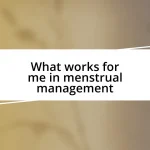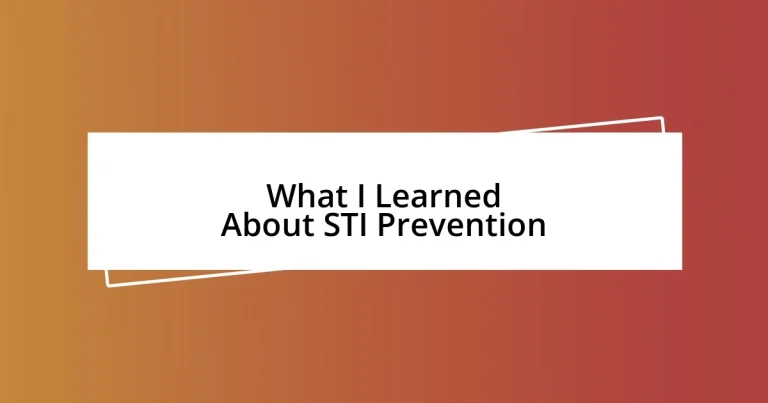Key takeaways:
- Open communication about STI prevention fosters trust and empowers individuals to make informed choices.
- Regular testing is essential for early detection, peace of mind, and informed discussions with partners about sexual health.
- Education and resources, including healthcare providers and community workshops, are crucial in overcoming stigma and enhancing awareness about STIs.
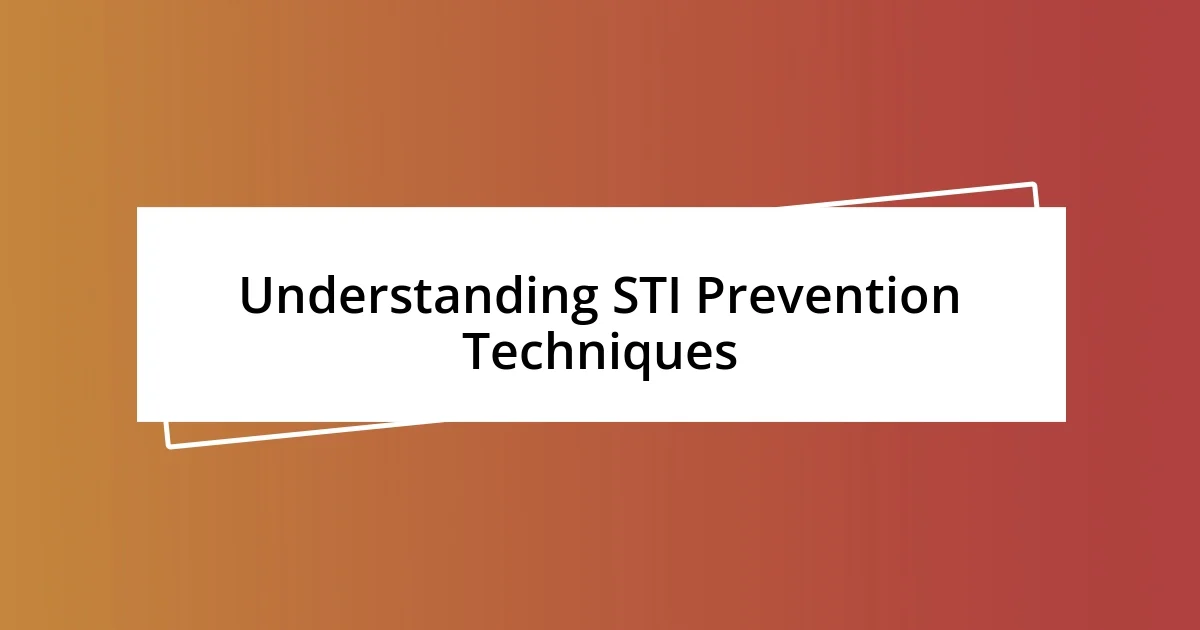
Understanding STI Prevention Techniques
Understanding STI prevention techniques often begins with open communication. I remember a time when a friend shared their anxiety about discussing safe practices with a partner. It struck me how vital it is to create a space for these conversations, as talking openly about STI prevention not only builds trust but also empowers individuals to make informed choices together.
In my experience, using barriers like condoms can significantly reduce the risk of contracting STIs. It’s surprising how many people don’t realize that effective usage is key—it’s not just about having them on hand, but knowing how to use them correctly. When I first learned this during a health class, it felt like I was uncovering a secret tool for protection, one that could help prevent not just STIs but unwanted pregnancies as well. Have you ever thought about how something so simple can have such a profound impact on one’s health?
Vaccination is another crucial technique often overlooked. I personally felt a wave of relief when I got vaccinated against HPV. It opened my eyes to the importance of preventive measures. Do you know that some STIs can be prevented through vaccines? Understanding these techniques allows us to take charge of our sexual health and, ultimately, our lives.
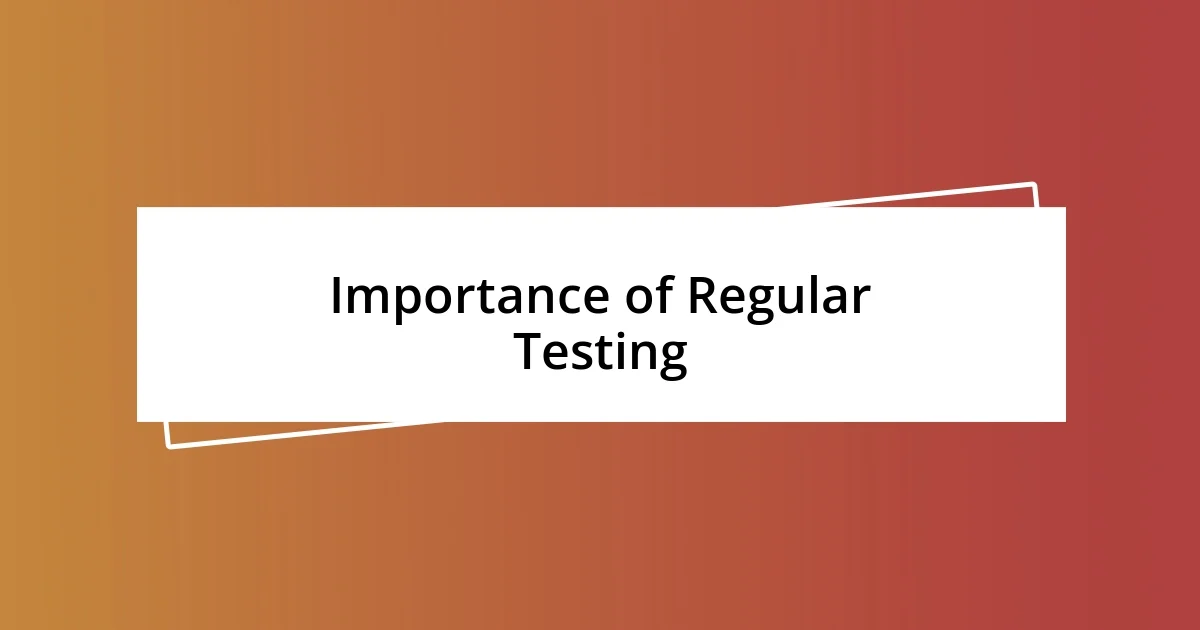
Importance of Regular Testing
Regular testing for STIs is essential for maintaining not just individual health but also the well-being of partners. I recall a conversation with a close friend who had been putting off getting tested. The fear and uncertainty weighed heavily on him, yet he didn’t realize that knowledge could empower him. It struck me how regular testing removes the guesswork and can significantly reduce anxiety around STIs, allowing for healthier relationships and informed decisions.
Here are a few key reasons why regular testing matters:
- Early Detection: Most STIs can be asymptomatic, meaning one may not show symptoms but could still spread the infection. Regular check-ups can catch issues before they escalate.
- Peace of Mind: Knowing your status eliminates uncertainty, allowing you to engage in relationships with confidence.
- Better Treatment Options: The sooner an STI is detected, the more effective treatment can be, preventing potential complications.
- Community Health: Regular testing not only protects you but also your partners and the wider community. It fosters a culture of responsibility.
- Informed Decisions: By knowing your STI status, you can have open discussions with partners about safety and prevention strategies.
Each of these points reinforces why it’s vital to prioritize regular testing in our lives. It’s not just about compliance; it’s about embracing responsibility for our health and those we care about.
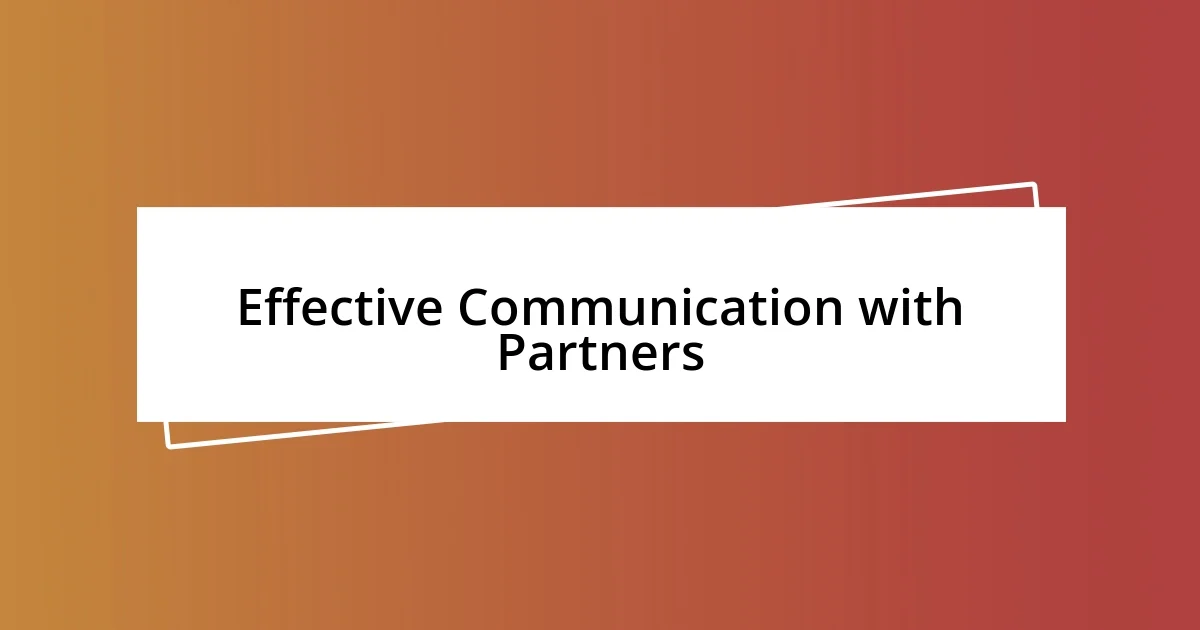
Effective Communication with Partners
Effective communication with partners about STI prevention can feel daunting but is essential for fostering trust. I’ve been in situations where broaching the subject felt nerve-wracking, yet, once I initiated the conversation, it surprisingly opened up a channel for both of us to express our concerns and expectations. That little nudge to talk can lead to a much deeper connection.
Building on that idea, I found it helpful to choose the right time and setting for these conversations. One memorable evening, after an intimate dinner, I proposed the topic, and instead of rejection, we both engaged in a heartfelt dialogue. This experience taught me that timing plays a significant role in how receptive partners are to discussing such sensitive subjects. Have you ever experienced a moment where the right words at the right time made all the difference?
Lastly, it’s vital to approach the topic without judgment. I recall a former partner who initially felt defensive when the subject came up, but by maintaining a calm and understanding demeanor, it turned into a productive conversation. This reinforced my belief that expressing genuine care for each other’s well-being allows for more honest exchanges and better mutual understanding about STI prevention.
| Communication Approach | Outcome |
|---|---|
| Initiating with openness | Strengthens trust and connection |
| Choosing the right moment | Enhances receptiveness and engagement |
| Non-judgmental attitude | Encourages honesty and collaboration |
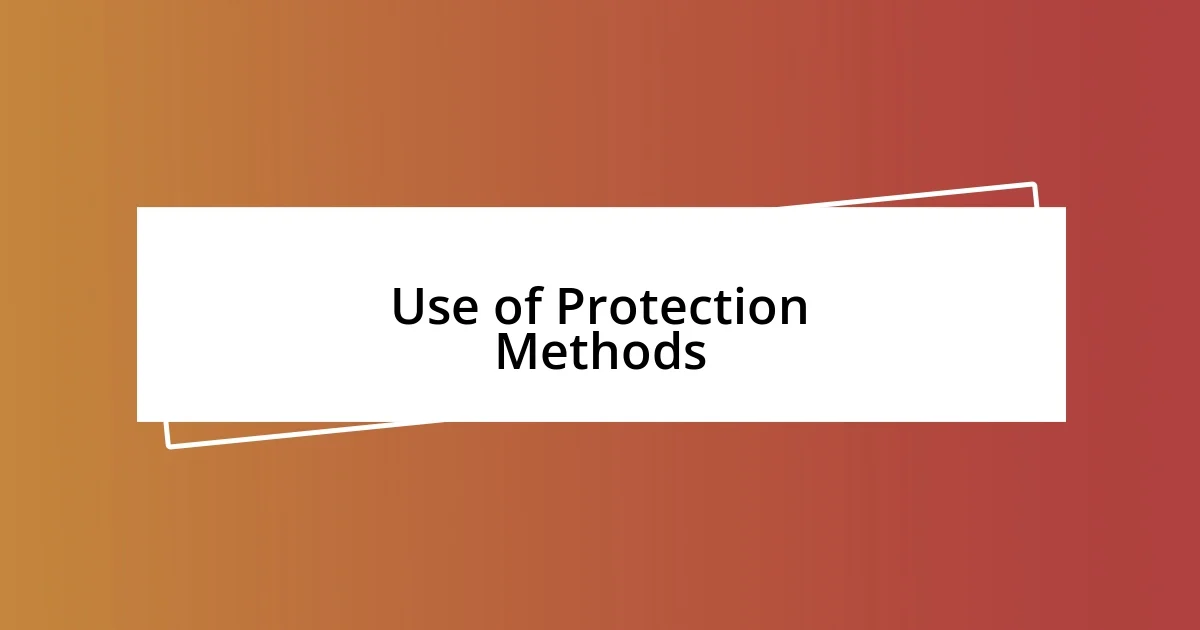
Use of Protection Methods
Using protection methods is an essential aspect of STI prevention. Personally, I remember my first time purchasing condoms. It felt awkward, but once I got past the embarrassment, that small act empowered me. Just like that first step, consistently using condoms and dental dams can significantly reduce your risk of transmission, offering peace of mind during intimate moments. Have you ever considered how a simple barrier could change your entire experience?
Beyond condoms, there are other forms of protection to consider. I’ve recently explored PrEP (pre-exposure prophylaxis), which is a daily medication for HIV prevention. My initial hesitation came from uncertainty about its effectiveness and side effects. However, after researching and speaking with a healthcare provider, I discovered it can offer significant protection when used correctly. Isn’t it intriguing how various methods enhance our options for safer intimacy?
Lastly, it’s crucial to understand that no single method is foolproof. The idea of combining multiple protection strategies can feel daunting, but I found it reassuring. For instance, when I started using condoms along with regular testing and discussing my status openly with partners, it created a safety net that allowed me to feel more liberated. What strategies do you think you could combine for better protection?
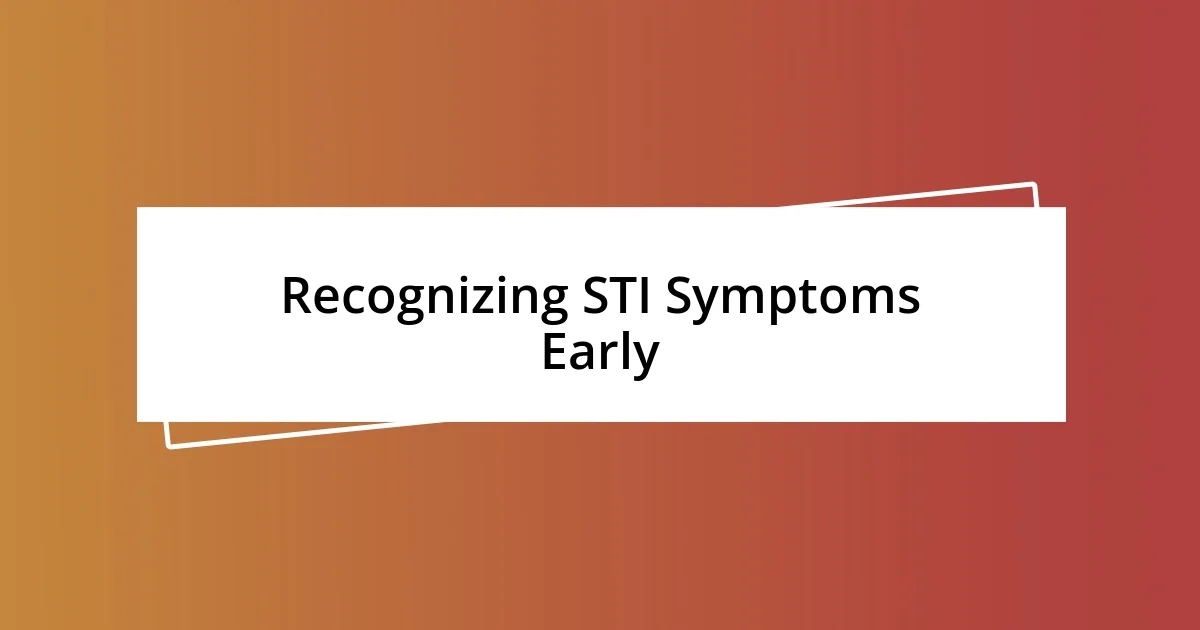
Recognizing STI Symptoms Early
Recognizing STI symptoms early can be a game changer in taking charge of your sexual health. I remember a time when I noticed unusual discharge and burning during urination. It’s one of those moments that can make your heart race, but instead of panicking, I decided to be proactive. I reached out to my healthcare provider, who assured me that early intervention significantly improves outcomes. Have you ever found yourself caught off guard by your body sending a warning signal?
Understanding what constitutes “normal” can help us identify when something seems off. I’ve learned to pay attention to any changes in my body—like unexplained rashes, sore throats, or discomfort in the genital area. It’s so easy to brush these signs aside or attribute them to something minor, but acknowledging them can lead to timely medical advice. Isn’t it empowering to know that your body is trying to communicate with you?
Seeking treatment at the first sign of symptoms is not just about protecting yourself; it’s about safeguarding your partners too. There was a time I ignored my instinct to get checked, thinking it would resolve on its own. Looking back, I realize how crucial early recognition was in preventing further complications. If I had acted sooner, it might have made all the difference. What would it take for you to trust your instincts and seek help at the first sign of a potential issue?

Resources for STI Education
I’ve always found that education is the cornerstone of STI prevention. Websites like the CDC and WHO offer a treasure trove of information, but I also cherish local resources. Attending community workshops opened my eyes to vital discussions around STIs, and I made connections with others who shared similar concerns. Have you ever left a seminar feeling more informed and empowered to make choices?
Books and pamphlets can be a bit dry, but sometimes I stumble upon a real gem. I remember reading a straightforward guide on sexual health that broke down complex topics into relatable stories. The more I learned, the more confident I felt discussing STIs openly with my friends. Isn’t it amazing how accessible information can lead to more honest conversations?
Finally, don’t overlook your healthcare provider as a resource. I’ve had some of my most enlightening discussions during routine check-ups. My doctor always made it a point to discuss prevention methods tailored to my lifestyle. It’s reassuring to have a trusted professional to turn to. How often do you engage with your provider about sexual health, and what insights could you gain from those conversations?
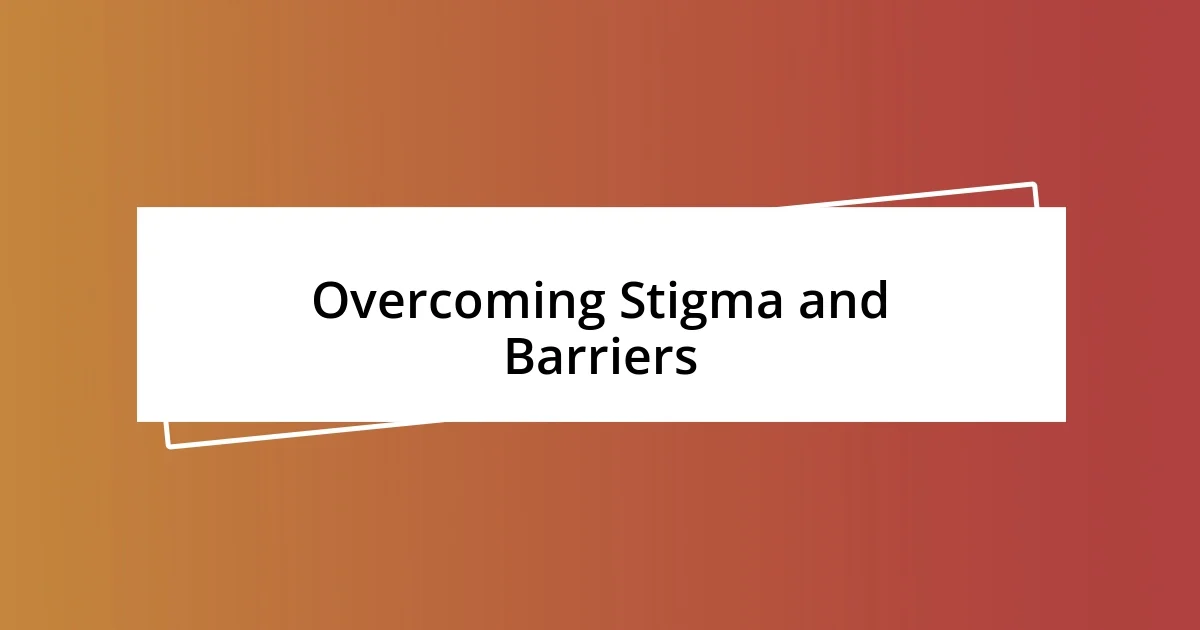
Overcoming Stigma and Barriers
It’s fascinating how stigma plays such a significant role in STI conversations. I remember having a friend who felt too embarrassed to seek treatment, despite showing clear signs of an infection. It made me realize that many people—myself included at times—are often hesitant to engage in discussions about STIs, fearing judgment or misunderstanding. What if we could create an environment where asking questions felt as normal as discussing any other health concern?
Overcoming these barriers requires openness and education. One day, during a casual chat, my sister shared her experience of getting tested; she spoke about the relief she felt after confronting her fears. That moment sparked a deeper conversation among our friends about how we could support one another. It’s true what they say: when we share our stories, we often encourage others to speak up and seek help. Have you ever noticed how vulnerability can foster strength within a community?
I believe it’s essential to actively challenge the myths surrounding STIs. For instance, many still think only certain demographics are affected, leading to a skewed perception of vulnerability. I once attended a seminar where an engaging speaker laid out the facts without sugar-coating the risks. It was eye-opening! Knowing that the truth can empower people to prioritize their health is so important. How can we continue to spread accurate information to dismantle these misconceptions together?
